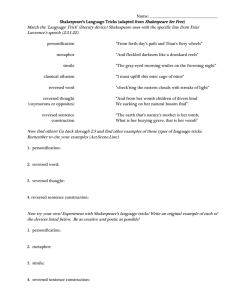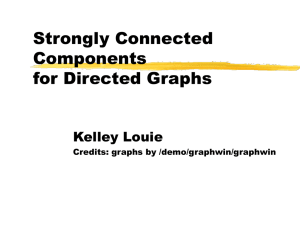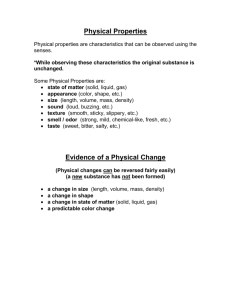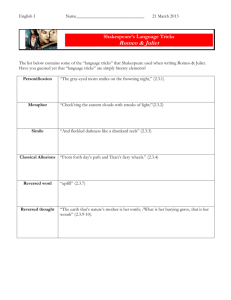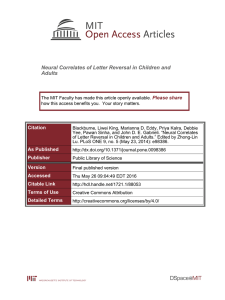Here: There
advertisement
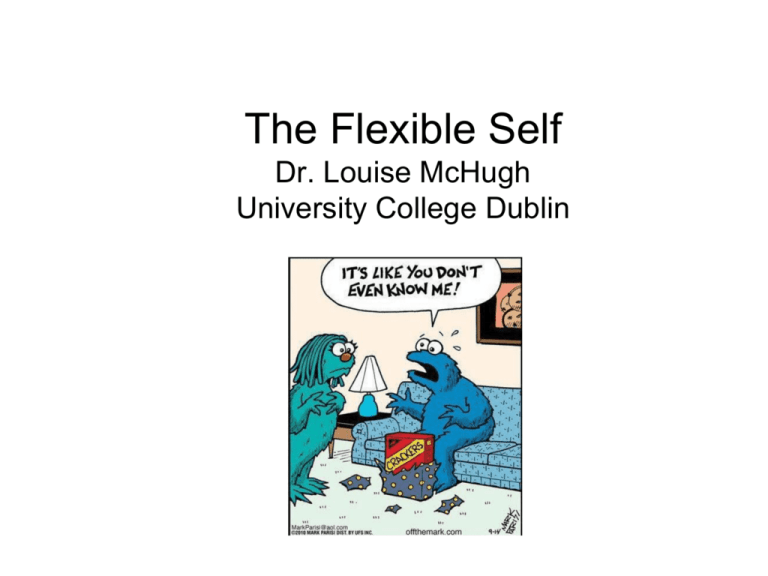
The Flexible Self Dr. Louise McHugh University College Dublin Where is your ‘self’? YOU ARE HERE! Ferrari et al 2008 I was so stressed yesterday, I wasn’t myself! Then who were you? Social animals… A sense of self? • Only humans have a sense of self • Why? • Humans have language Symbolic relationships between things… • Is what allows us to make sounds that other people understand rather than simply pointing and grunting at things ‘HAT’ ‘Kelly’ Physical Relationships Relationships based on cues = CONTEXTUAL CUE = CONTEXTUAL CUE Nic BAD OK Nic IS SAME AS BAD GOOD CONTEXTUAL CUE Language Just as we learn to manipulate the environment with our body and hands We also learn to manipulate it through sound and symbols Milk Please! We can relate in many ways • • • • • Same as (‘Jumjaw is the same as dog’) Opposite (‘Day is opposite to Night’) Different (‘Boys are different from Girls’) Comparison (‘£1 is more than 10p’) Perspective (‘I am here and you are there’) Transformation of Functions If someone has a fear of dogs, and they are told that ‘jumjaw’ is another word for dog, then fear may be elicited upon hearing ‘ Here comes a jumjaw!’ Psychological Function is a ‘DOG’ is a ‘Jumjaw’ Psychological Function • So language is responding to abstract relations • So what does that have to do with the ‘self’? ‘I think No Rene – you learn to therefore I am’ verbally discriminate your own behavior from others behavior - therefore you are What did YOU have for breakfast? I had a banana for breakfast No silly I had a banana for breakfast As a child begins to relate more and more of their own behavior… I feel happy I feel sad …and to compare it with that of others… II am than am happier not as happy you! as you I ama adepressed happy I am person! person! …they begin to have a concept of self Understanding others? ‘The key to a happier world is the growth of compassion’ Dalai Lama Theory of Mind Module I Know what you are thinking! I have a ‘module’ in my brain that tells me! CBS Approach to PerspectiveTaking • Perspective relations specify a relation in terms of the perspective of the speaker Consider the three relations of: I versus YOU HERE versus THERE NOW versus THEN CBS Approach to PerspectiveTaking Each time a child is asked or answers questions such as: “What are you doing here?” “What was I doing then?” “What am I doing now?” “What were you doing there?” the physical environment will likely be different… The only constant across such questions are the relational properties of: I versus You Here versus There Now versus Then CBS Approach to PerspectiveTaking Two important variables: Relation Type • • • I / YOU HERE / THERE NOW / THEN Complexity • • • Simple Relations Reversed Relations Double Reversed Relations McHugh, et al., (2004) A Simple Relation Task I have a white brick and you have a red brick Which brick do you have? Which brick do I have? A Reversed Relation Task I am sitting here on the blue chair and you are sitting there on the black chair Here: There: If I was YOU and YOU were ME Where would I be sitting? Where would you be sitting? A Double Reversed Relation Task Yesterday I was sitting there on the black chair, today I am sitting here on the blue chair There: Here: Now: Then: If HERE was THERE and THERE was HERE and NOW was THEN and THEN was NOW Where would I be sitting now? Where would I be sitting then? 3-5 year olds perform worst If I was YOU where would I be sitting? I don’t know! McHugh, et al., 2004 Weil et al., (2010) It can be trained Simple Reversed Double Reversed More relating on tasks about others? Example of Self Belief task If I put the pencils in the smarties box and you are not there I would think the smarties box contains SMARTIES (F) Example of Other’s Belief task If you put the pencils in the smarties box and I am not there You would think the smarties box contains PENCILS (T) McHugh, et al., (2007) 1.6 Self belief tasks involve less relating SIGNIFICANT* 1.4 Trial Type 1.2 R e s p o n s e 1 0.8 OTHER T i 0.6 m e s SELF 0.4 0.2 0 Self TB true Self TB false Self FB true Self FB false Another TB true Another TB false Another FB true Trial-Type Response Times * There were significant differences in response times between Self versus Other tasks (p <.05)* Another FB false Autism-related and schizophrenia spectrum disorders ASD: Rehfeldt, et al., 2007 • Children with high-functioning autism or asperger syndrome performed worse on the RFT PT protocol than their age-matched typically developing counterparts Children diagnosed with ASD do worse Proportion of participants scoring over 0.67 Villatte, et al. (2009): Patients with Schizophrenia 1 0,8 Controlled for IQ 0,6 0,4 0,2 Reversed Simple Double Reversed 0 I-You simple Here-There simple Now -Then simple I-You reversed Here-There reversed Trial-Type Patients do worse on reversed and double reversed Now -Then reversed I-You/HereHereThere There/Now double Then double reversed reversed Controls Patients Villatte, et al. (2010): Patients with Schizophrenia Proportion of participants scoring over 0.67 1 0,8 0,6 0,4 0,2 0 Self/True belief Self/False belief Other/True belief Other/False belief Controls Trial type Patients do worse on other and false belief Patients Villatte, et al. (2010) Non-clinical pts high social anhedonia Mean rate of accuracy 1 0,8 0,6 0,4 0,2 0 I-You Here-ThereNow -Then I-You Here-ThereNow -ThenI-You/Here- Heresimple simple simple reversed reversed reversed There There/Now double Then reversed double reversed Trial-Type Co ntro l Experimental SA do worse on double reversed Belief attribution 1 Mean rate of accuracy 0,9 0,8 0,7 0,6 0,5 Self Other Attribution type SA do worse on other belief Control Experimental So how does this link to ACT? Double Edged Sword Verbal self-knowledge is a two-edged sword It can be important and beneficial to human beings while it can also be a cause of pain and suffering ‘I wish I…’ Were as good at presenting as Robyn Were as smart as Dermot Were as young as I am in this photo! Had great hair like Russ Comparison is a bitch Even if you are a mega star… 1969 I am not good enough as I am. In order to be good enough I need to look a certain way 1979 1989 2009 3 Selves in ACT • Self as content Story • Self as process Contacting the present • Self as context Flexible Perspective Taking SELF AS CONTENT I’m not good enough. I am too anxious SELF AS PROCESS I HERE NOW notice my thoughts and feelings and what I can see, hear, touch taste and smell SELF COMPASSION I HERE NOW notice my pain and respond with kindness TRANSCENDENT SELF I HERE NOW am the observer of my thoughts and feelings EMPATHY I HERE NOW notice that you are feeling sad Training Flexible Perspective Taking Step 1. Basic Perspective Training ‘If I were you, where would I be?’ ‘If I were you and here was there, where would I be?’ Step 2. Empathy Training ‘I feel sad. If you were me, how would you feel?’ ‘I’ve won a prize. If you were me, how would you feel?’ Step 3. Self-as-Context ‘I watch thoughts and feelings come and go. Who is it that is watching them?’ Vilardaga & Hayes, 2009 Informing intervention? DSM Category RFT conceptualisation Intervention ASD Reduced or absent deictic framing Reversal and double reversal perspective training Schizophrenic Limited reversal and double reversal deictics Reversal and double reversal perspective training Socially anhedonic Limited reversal and double reversal deictics Reversal and double reversal perspective training Sociopath Reduced or absent ToF of Perspective training in emotional functions due emotional funcs to reduction or absence of emotional functions Fusion with I-bad Self as Context training Depression No self as context More on this… Thank you!
